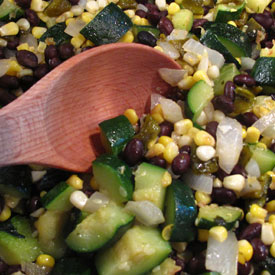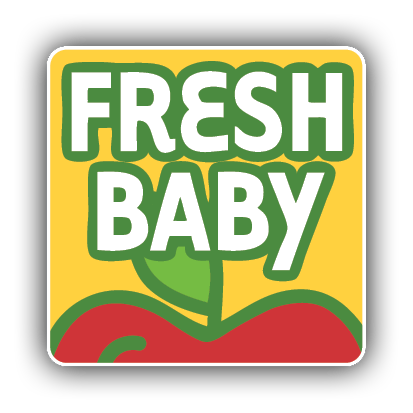
All About Corn:
Corn is the number one food crop in the America because it is a food source for both human and animals. The Native American name for corn is “mahiz”, which means “that which sustains us.” Early settlers transformed the word to “maize”, and then eventually started calling it “corn” because of the small size of the grains, or kernels. Scientists estimate that today’s corn is a descendant of a type of wild grass found in a tropical river valley in Mexico. It is thought that versions of corn similar to what we eat now began being cultivated over 9,900 years ago.
Corn can be classified as either a grain or a vegetable depending on what form it is served. Raw corn served fresh on the cob or heated from a freezer package or can is considered a vegetable. Dried corn, such as popcorn, and products made with corn meal such as corn bread and corn tortillas, is considered a grain.
Nutrition:
Corn is an excellent source of fiber and can help ease digestive issues because it absorbs water as it travels through the digestive tract. Corn is also a great source of folate, which helps prevent birth defects and heart disease. Lutein, one of the antioxidants found in corn promotes good eye health.
At The Market:
Choose the freshest corn available because once it is picked, the natural sugars begin turning to starch and it loses its sweetness. Look for corn whose husks are green and not dried out. Gently pull back the tip of the husk and look to see that the kernels are plump and shiny. It is best to eat fresh corn within one or two days of picking. The longer you wait you’ll notice a difference in sweetness and texture. Older ears of corn tend to be chewy compared with fresher corn which is crisper.
When buying dried corn products, choose products made with “stone-ground cornmeal” over products made with processed or refined corn. When buying popcorn, choose microwave or stove top popcorn without artificial flavorings and butter.
Storage & Cooking:
Store corn with the husk on in an air-tight container or sealed plastic bag in the refrigerator. Leaving the husks on will hold the moisture and protect the flavor.
Corn on the cob can be prepared in many ways. Boiling peeled corn for a few minutes is the most popular cooking method. Steaming or microwaving peeled corn is also a quick and easy option. Roasting or grilling with the husk on and peeling just before eating works well too. The most important aspect to cooking corn is to keep cooking time short. Overcooked corn can become chewy and flavorless.
Freezing Corn: Fresh corn freezes well and locks in nature’s sweetness that can be enjoyed in months when corn is out of season. To prepare whole ears for freezing, peel them and drop the ears in boiling water for 5 minutes. Cool the ears quickly in ice water. Freeze ears of corn in freezer storage bags. To freeze just the kernels, follow the same instructions above. When the ears are cool, cut the kernels off the cob. Frozen whole corn on the cob will keep for up to one year. Frozen kernels will stay for two to three months.
Corn for the Family:
There are countless ways to enjoy nutritious corn. Fresh on the cob with a small pad of butter is delish!
Cutting corn kernels off the cob creates many more options to include it in your family meals. Corn tastes great in:
- Salads, soups and casseroles
- Salsas and dips
Corn is a great addition to a mixed vegetable medley. Here is a recipe that combines corn, green chilies, zucchini, onions, and black beans.
Calabecitas


Ingredients:
- 2 medium-sized zucchini, diced
- 1 can green chilies, diced
- ½ large onion, diced
- 2 ears fresh sweet corn or 1-1/2 cups of frozen corn
- 1 can (15 oz.) black beans
- 2 Tbsp. olive oil
- Salt and fresh pepper, to taste
Directions:
Pour back beans in colander and rinse for 1 minute under cold water. Remove husks from corn and cut kernels off the cobs. In a large sauté pan, heat olive oil over medium heat. Add onions, corn, green chile and zucchini. Cover, stirring occasionally, and cook until zucchini and onion is softened, about 10 minutes. Reduce heat to low and gently stir in black beans and continue cooking to heat the black beans about 1-2 minutes. Add salt and pepper to taste. Serve.
Corn as a Whole Grain:
Popcorn is a great after school snack. Use a microwave or air popper to make popcorn. Dress up your popcorn with a drizzle of melted butter and one of these seasonings ideas:
- Cinnamon and Sugar
- Parmesan Cheese and Lemon-pepper
- Garlic salt
- Old Bay seasoning
- Smoked paprika and olive oil
- Dash of unsweetened cocoa and Sugar
Make Cornbread as side dish for soup, stew or chili. Try this recipe for Coconut Cornbread.
Coconut Cornbread

Ingredients:
- 1 ¼ cup All-purpose flour
- ¾ cup Cornmeal
- 1/4 cup Sugar
- 2 tsp. Baking powder
- ½ tsp. Pumpkin pie spice
- ½ tsp Salt
- ½ cup Milk
- ½ cup Coconut milk
- ¼ cup Vegetable oil
- 2 eggs
- ½ cup Sweetened coconut
Directions:
Preheat oven to 400 and grease 8 or 9-inch baking pan. Combine the dry ingredients. Stir in milk, coconut milk, oil, egg and coconut mixing until dry ingredients are moistened. Pour batter into the baking pan. Bake 20-25 minutes or until golden brown and a wooden pick inserted in the center comes out.


